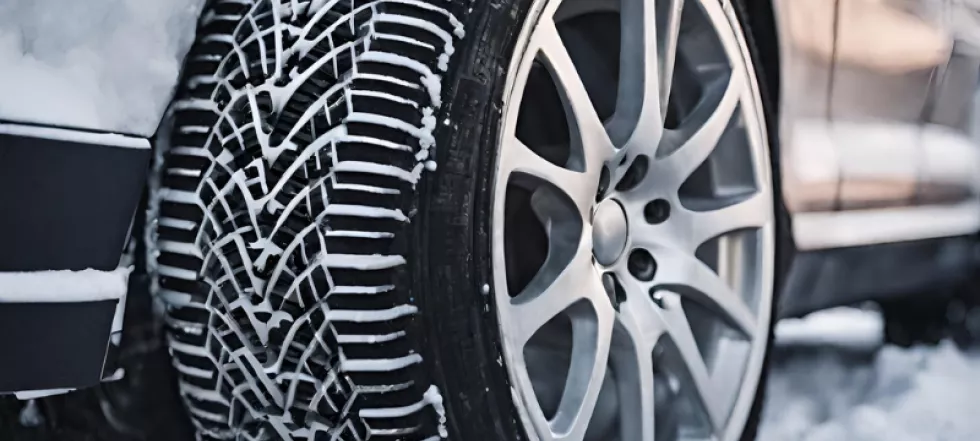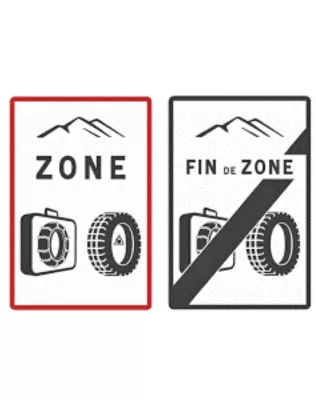
Fulli's tips for preparing your car for winter
Winter is coming! It's time for cosy afternoons by the fire, roasting chestnuts, raclette evenings and ski vacations. With your hat, sweater and scarf, you're all set for winter. But what about your car? Cold, ice, fog and snow put your vehicle to the test. From flat batteries and icy windshields to slipping on icy roads, here's Fulli's advice on how to adapt your driving and prepare your car for a trouble-free winter.
Get your car ready for winter
Coming into force in 2021, the Loi Montagne makes winter equipment mandatory: snow tires, 4-season tires with 3PMSF marking, chains or snow socks. From November 1, 2023 to March 31, 2024, all four-wheeled vehicles are affected in 34 mountain departments.
Snow tire or 4-season tire? It all depends on whether or not you have to drive on regularly snow-covered roads and in particularly harsh weather conditions.
A snow or winter tire is designed to offer optimum performance in temperatures ranging from +7°C to -20°C. Ideal for use on wet, cold and snowy surfaces, and to a lesser extent on black ice. The tread of winter tires has a large number of sipes, small incisions whose role is to grip snow and slippery ground. As soon as the temperature rises above 7°C, the tire loses its effectiveness on both wet and dry surfaces.
The 4-season tire is at ease between -10°C and +30°C. It performs well on wet and dry surfaces, but is much less effective than a winter tire in extreme conditions.
If you've decided to head off to the mountains for your next winter vacation, and you're not equipped with snow tires, it's essential to have chains or socks for safe driving. Don't forget to put them in your trunk before you set off, because fitting this equipment becomes compulsory as soon as you see the B58 sign. This is a sign circled in red with a tire and chains. Exit zones are indicated by the B59 sign.
Compulsory under the Highway Code, failure to use winter equipment can result in a fine of 135 euros, and the immobilization of your car.
What's more, in the event of an accident, your insurer may not cover the damage. Our little tip: practice fitting your equipment before you leave, to avoid stress on the roadside!

Winter in an electric car, it's possible
The cold sensitivity of electric cars has an impact on their battery range in winter. Depending on the car model, you can lose from 30% to 50% of range. In addition to reduced range, the colder it gets, the longer it takes to charge.
Two tips to prepare your car for winter and optimize electric recharging: maintain a speed of 100 km/h to 110 km/h on the freeway, and preheat your electric car 15 minutes before departure while it's still charging.
Be aware that heating the interior of an electric car consumes a lot of energy. Unlike an internal combustion engine, which uses engine heat, an electric vehicle uses battery energy to produce heat.
To overcome this drawback, many manufacturers now offer heat pump systems that redirect heat to the occupants and the battery. Heat pump heating requires 1 to 2 kW of power, as opposed to 6 kW for traditional living space heating. It is also possible to use additional heating devices for the seats and steering wheel at start-up, while the car warms up.
And to make your journey easier, 100% of service areas on the APRR and AREA networks are equipped with fast and ultra-fast electric charging stations (4 to 20 ultra-high-power charging stations - 140 to 350 kW - per station). All types of electric vehicle are accepted, and all connectors are available.
A word of advice? Pay for your recharging with the Fulli Electric Recharging Card, the access and payment card connected to the largest electric recharging network with 60,000 recharging stations in France, and also usable in Europe (Netherlands, Belgium, Germany, Italy, Spain and Ireland).
Prepare your windscreen for winter
If your car sleeps outside, winter conditions mean that your windscreen is covered in more or less thick frost. When it's time to leave, you're off for a morning windscreen scraping session.
To save time, melt the ice using the defrost function before starting to scrape. Never pour hot water, as the thermal shock from the rapid hot-cold contrast could damage the windscreen. There are also de-icing sprays and old-fashioned recipes, such as sprinkling a solution of 2/3 vinegar and 1/3 water on the windows once a month, or placing a cloth soaked in salt water under the wipers.
Only use the wipers when the windshield is de-iced, otherwise you risk damaging your wiper blades. And remember to add antifreeze to the washer fluid. It's effective down to -25°C.
The best way to gain 15 minutes' sleep in the morning is to prevent frost from forming, by protecting your car for the night with a tarpaulin or by placing a large piece of cardboard on the windscreen while raising the wipers.
Even if this inconvenience puts your nerves to the test, never take to the road in poor visibility. In addition to the fine (3 points and 90 euros, according to article R316 paragraph 1 and 3 of the Highway Code), it's your safety and that of others that's at stake.
Adapt your driving style to weather conditions
Whether starting off on a snow-covered road or braking on an icy surface, winter driving calls for caution and anticipation. First of all, it's imperative to reduce speed, accelerate smoothly and increase safety distances to adapt to weather conditions.
On snow, braking distance is multiplied by four. Avoid sudden movements both when accelerating and braking, and use your engine brake to slow down. If you use an automatic gearbox, switch to manual or sequential mode to benefit from engine braking.
In the event of snowfall, front fog lamps can replace or supplement low-beam headlamps.
If you're wearing snow chains or socks, make sure you keep to a maximum speed of 50 km/h to ensure safe driving. Finally, you must not overtake snow clearing or salting vehicles with the blue flashing light on. The Highway Code provides for a 4th-class fine and up to 3 years' suspension of driving licence.
All the way to a carefree winter on the slopes
You're all set to hit the road in winter conditions: luggage, winter gear and jumper cable in the boot. The APRR and AREA Alpine freeway network gives you access to the world's leading ski area. Ideal access to the Arve Valley and the resorts of Bonneville, Cluses, Flaine and Samoëns. Or further south to Les Houches, Chamonix-Mont-Blanc or Argentière. Or Val Montjoie to Les Contamines and Saint-Gervais, or Val d'Arly to Combloux, Megève or Praz sur Arly.
To save time at the freeway tolls, especially during the busy vacation season, take advantage of non-stop passage at 30 km/h in lane 30 with your Fulli Télépéage badge. Payment is automatic. The customer account can be managed either directly via the Fulli app or on the customer area of the fulli.com website.
